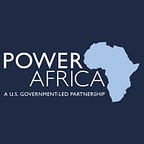Electrifying Africa Based on the U.S. Rural Electrification Model
A Historical Approach to Solving a Modern Problem
As utilities across the U.S. urgently work to restore power to the millions of Americans affected by Hurricanes Harvey and Irma, we are reminded of how difficult and dangerous life can be without electricity, even for just a few days. Approximately 600 million people in sub-Saharan Africa have never had access to electricity at all.
Power Africa, a U.S.-led initiative to double access to electricity in sub-Saharan Africa, is harnessing American experience and expertise to tackle one of the world’s biggest development challenges. This week, Power Africa visited the Adams Columbia Electric Cooperative, part of the Wisconsin Electric Cooperative Association (WECA), many of whose line workers volunteered to rebuild grids in Florida — applying the same skills required in countries like Liberia, where those without electricity suffered some of the worst impacts of the Ebola epidemic.
Less than a century ago, 90 percent of rural communities in the United States lacked access to power, depriving Americans of access to quality health care, education, and employment. The key challenge then was the same one we see in sub-Saharan Africa today: in remote areas, utilities face higher costs and a highly dispersed lower-income customer base. Success in the U.S. required a new business model and a strong political push from President Franklin Roosevelt, who saw rural electrification as a way to drive employment, enable more efficient agriculture, and bridge the urban-rural divide.
Rural communities across the U.S. established non-profit, farmer-owned cooperatives, taking out low-interest loans from the newly created Rural Electrification Administration (REA). In under two decades, 93 percent of US farms were electrified, and the default rate on loans was less than 1 percent. Today, 897 cooperatives serve 42 million people. NRECA represents their interests and provides technical assistance around the world, including in partnership with Power Africa. So what can sub-Saharan Africa learn from the U.S. experience?
Learn from the cooperative model. A community-driven approach can help expand electricity to dispersed, low-income populations. With the applied expertise of groups like NRECA, African countries can advance this model where it makes sense.
Build consumer demand. Most newly electrified households consume very little power, making them a risky business proposition. In the U.S., the REA taught communities how to use and maintain appliances and provided credit for purchases from appliance manufacturers, including Power Africa partner General Electric. In sub-Saharan Africa, off-grid companies are tackling this challenge by pairing solar systems with innovative off-grid appliances.
Take advantage of new technology. The year 2017 presents sub-Saharan Africa with opportunities to build beyond the U.S. model. New technologies — including cheap, mobile solar panels and prepaid meters — enable a more efficient, flexible approach and a chance to optimize the use of grid extension, micro-grid and off-grid solutions.
Power Africa brings together more than 150 public and private partners, including NRECA. With American leadership and private sector ingenuity, we can help achieve the same rapid electrification gains in sub-Saharan Africa that the U.S. saw not so very long ago.
Andrew M. Herscowitz is the Coordinator for Power Africa, a U.S. government-led partnership to double access to electricity in sub-Saharan Africa. Kathleen Auth is the Deputy Director for Energy at Power Africa and leads Power Africa’s efforts to connect people to the grid.
Power Africa is a U.S. Government-led initiative launched in 2013 to unlock the substantial natural gas, wind, solar, hydropower, biomass, and geothermal resources on the continent through partnerships. To date, Power Africa has leveraged over $50 billion in commitments from the public and private sectors, including more than $40 billion in commitments from the private sector. 7,200 MW that have reached financial close and have helped provide over 10 million connections, which means tens of millions of people have access to electricity that did not prior to Power Africa’s launch in 2013 while supporting U.S. jobs and U.S. businesses.
For more information, visit www.usaid.gov/powerafrica
